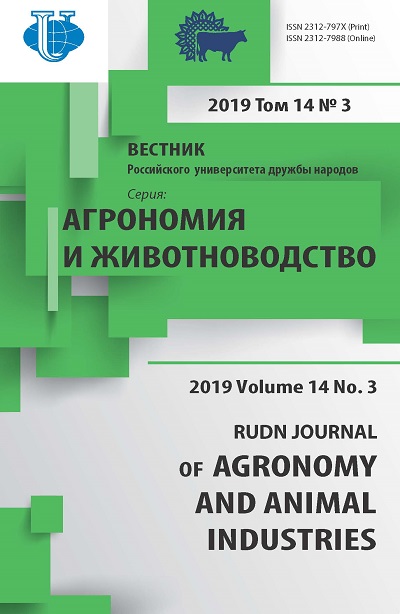Nutritional value of vegetable Amaranthus tricolor L. seedlings grown in Moscow region
- Authors: Sergiev I.G.1, Todorova D.A.1, Gins V.K.2, Motyleva S.M.3, Gins E.M.4, Moskalev E.A.4
-
Affiliations:
- Institute of Plant Physiology and Genetics, Bulgarian Academy of Sciences
- Federal Scientific Vegetable Center
- All-Russian Horticultural Institute for Breeding, Agrotechnology and Nursery
- Lorch Potato Research Institute
- Issue: Vol 14, No 3 (2019)
- Pages: 225-238
- Section: Crop production
- URL: https://agrojournal.rudn.ru/agronomy/article/view/19509
- DOI: https://doi.org/10.22363/2312-797X-2019-14-3-225-238
- ID: 19509
Cite item
Full Text
Abstract
The use of amperometric express method made it possible to measure quickly and evaluate content of waterand alcohol-soluble antioxidants in extracts from Amaranthus tricolor L. plants. Accumulation of low molecular weight antioxidants: ascorbic acid, beta-cyanine (amaranthine) and the total content of antioxidants in various organs of Valentina amaranth seedlings were studied. The maximum amount of low molecular weight antioxidants accumulates in leaves, compared with roots and stems of seedlings grown in open and protected ground. In open ground conditions, amaranth leaves and stems have 1.5-fold and 2-fold increased level of ascorbic acid than seedlings grown in protected ground. But the total content of water-soluble antioxidants in leaves and roots of seedlings is lower compared to seedlings of protected ground. Minimum amount of antioxidants was found in alcohol extracts of stems and roots in open ground, while the total content of antioxidants in stems and roots was 1.6 fold higher in seedlings grown in protected soil. The content of amaranthine is comparable in the studied organs of amaranth seedlings of both cultivation variants. The data obtained allow to recommend use of leaves and stems of amaranth seedlings grown in open and protected ground (early spring and autumn), as a preventive antioxidant dietary product.
About the authors
Iskren Georgiev Sergiev
Institute of Plant Physiology and Genetics, Bulgarian Academy of Sciences
Author for correspondence.
Email: iskren@bio21.bas.bg
Associate professor, PhD, Institute of Plant Physiology and Genetics
Sofia, BulgariaDesislava Aleksandrova Todorova
Institute of Plant Physiology and Genetics, Bulgarian Academy of Sciences
Email: dessita@bio21.bas.bg
Associate professor, PhD, Institute of Plant Physiology and Genetics
Sofia, BulgariaValentina Karlovna Gins
Federal Scientific Vegetable Center
Email: anirr@bk.ru
Doctor of Biological Sciences, professor, chief researcher at Laboratory of Plant Physiology and Biochemistry and Introduction
VNIISSOK village, Russian FederationSvetlana Mikhailovna Motyleva
All-Russian Horticultural Institute for Breeding, Agrotechnology and Nursery
Email: iskren@bio21.bas.bg
Candidate of Agricultural Science, Associate Professor, Head of Laboratory of Physiology and Biochemistry
Moscow, Russian FederationEkaterina Muratovna Gins
Lorch Potato Research Institute
Email: iskren@bio21.bas.bg
Junior Researcher
Kraskovo village, Moscow Region, Russian FederationEvgeny Aleksandrovich Moskalev
Lorch Potato Research Institute
Email: iskren@bio21.bas.bg
Junior Researcher
Kraskovo village, Moscow Region, Russian FederationReferences
- Rastogi A, Shukla S. Amaranth: A new millennium crop of nutraceutical values. Critical reviews in food science and nutrition. 2013; 53(2):109—125. doi: 10.1080/10408398.2010.517876
- Bhattacharyya B, Johri BM. Amaranthaceae. In: Bhattacharyya B, Johri BM. (eds.) Flowering plants: Taxonomy and phylogeny. Delphi: Narosa Publishing House; 1998. p. 113.
- Das S. Systematics and taxonomic delimitation of vegetable, grain and weed Amaranthus: a morphological and biochemical approach. Genet Resour Crop Evol. 2012; 59(2):289-303. doi: 10.1007/s10722-011-9684-7
- Peter K, Gandhi P. Rediscovering the therapeutic potential of amaranthus species: A review. Egyptian Journal of Basic and applied Sciences. 2017; 4(3):196-205. Available from: doi: 10.1016/ j.ejbas. 2017.05.001
- Rahmatullah M, Hosain M, Rahman S, Akter M. Antyhyperglycaemic and antinociceptive activity evaluation of methanolic extract of whole plant of Amaranthus tricolor L. (Amaranthaceae). Afr. J. Trad. Complement Altern Med. 2013; 10(5):408-411. doi: 10.4314/ajtcam.v10i5.31
- Aneja S, Vats M, Aggarwal S, Sardana S. Phytochemistry and hepatoprotective activity of aqueous extract of Amaranthus tricolor Linn. roots. J. Ayurveda Integr. Med. 2013; 4(4):211-215. doi: 10.4103/0975-9476.123693
- Clemente AC, Desai PV. Evaluation of the hematological, hypoglycemic, hypolipidemic and antioxidant properties of Amaranthus tricolor leaf extract in rat. Tropical Journal of Pharmaceutical Research. 2011; 10(5):595-602. doi: doi.org/10.4314/tjpr.v10i5.
- Sarker U, Islam MT, Rabbani MG, Oba S. Variability, heritability and genetic association in vegetable amaranth (Amaranthus tricolor). Spanish Journal of Agricultural Research. 2015; 13(2):1–8. doi: 10.5424/sjar/2015132-6843
- Sarker U, Islam MT, Rabbani MG, Oba S. Genotype variability in composition of antiox- idant vitamins and minerals in vegetable amaranth. Genetika. 2015; 47(1):85–96. doi: 10.2298/GENSR1501085S
- Robbins RJ. Phenolic acids in foods: an overview of analytical methodology. J. Agric Food Chem. 2003; 51(10):2866-2887. doi: 10.1021/jf026182t
- Berberich S. History of amaranth. Agric. Res. 1980; 29(4):14.
- Gins MS, Gins VK, Kononkov PF. Introduktsiya amaranta v Rossii [Amaranth introduction in Russia]. Мoscow. 2019. (In Russ).
- Gins MS, Gins VK, Kononkov PF, Pivovarov VF, Romanova EV, Osokin IE, Gins EM. Tekhnologiya vyrashchivaniya ovoshchnogo (listovogo) amaranta [Technology for growing vegetable (leaf) amaranth]. Moscow: RUDN Publ.; 2017. (In Russ).
- Baiwas M, Dey S, Sen R. Betalains from Amaranthus tricolor L. Journal of Pharmacognosy and Phytochemistry. 2013; 1(5):87-95.
- Sapozhnikova EV, Dorofeeva LS. Determination of ascorbic acid content in colored plant extracts by iodometric method. Food industry. 1966; (5):29—31. (In Russ).
- Gins M.S., Gins V.K., Baykov A.A., Romanova E.V., Kononkov P.F., Torres M.K., Lapo O.A. Metodika analiza summarnogo soderzhaniya antioksidantov v listovykh i listostebel'nykh ovoshchnykh kul'turakh [Methodology for the analysis of the total content of antioxidants in leafy and leafy vegetable crops]. Moscow: RUDN Publ.; 2013. (In Russ).
- Gins MS, Gins VK. Fiziko-biokhimicheskie osnovy introduktsii i selektsii ovoshchnykh kul'tur [Physico-biochemical fundamentals of the introduction and selection of vegetable crops]. Moscow: RUDN Publ.; 2011. (In Russ).
- Sarker U, Oba S. Drought stress effects on growth, ROS markers, compatible solutes, phenolics, flavonoids, and antioxidant activity in Amaranthus tricolor. Appl Biochem Biotechnol. 2018; 186(4):999-1016. doi.org/10.1007/s12010-018-2784-5
- Piattelli M. Betalains. In: Goodwin TW. (ed.) Chemistry and biochemystry of plant pigments. N.Y.: Acad. Press; 1976. p.560-596.
- Blokhina O, Fagerstedt KV. Oxidative metabolism, ROS and NO under oxygen deprivation. Plant Physiology and Biochemistry. 2010; 48(5):359–373. doi.org/10.1016/j.plaphy.2010.01.007
- Vladimirov YA, Proskurnina EV, Demin EM, Matveeva NS, Lyubitsky OB, Novikov AA. et al. Dihydroquercetin (taxifolin) and other flavonoids as inhibitors of the formation of free radicals at key stages of apoptosis. Biochemistry. 2009; 74(3):372-379.
Supplementary files















